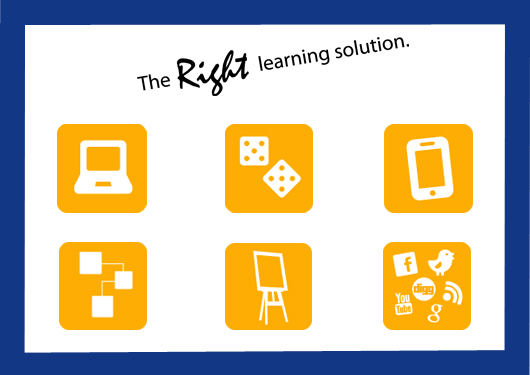
We’re pleased to announce a new blog series called eLearning Challenges. It looks at the real issues our clients face when developing learning solutions.
We are genuinely excited by the growth of mobile learning and game based learning solutions in the workplace… and many of the examples and case studies we will show in this blog series indeed fall into these categories. But at our core, BLP is most passionate about delivering the right learning solution for each client. That might be a course, game, app, or even an instructor-led session. Whatever method is chosen, the solution must be driven by the performance goal and learner profile.

Workplace learning has to be more focused and direct than learning in the K-12 space. Any technology we use has to solve a business need in order to have real value to our clients. When it comes down to it, workplace learning is supposed to help people do their jobs better. No matter what format you use, that should always be the goal.
So over the next several blogs, we will be sharing real stories of recent client work we have completed. In doing so, we are going to show how we worked with the client to meet their eLearning challenges. While every situation is different, we tend to see certain challenges surface in many organizations. I recently sat down with Sharon Boller to pin down what the most common challenges are, and she gave me quite a list. Do any of these sound familiar?
Common Challenges Our Clients Face
- Limited budgets – this dramatically affects the types of learning solutions that can be considered.
- Limited time and attention available from subject matter experts who they need to be part of their projects. This can make it difficult to produce something in an expedited timeline or fashion.
- Lack of control over legal reviews, required in many companies for anything that will be externally facing. Most of our clients are at the mercy of others when it comes to reviews. They don’t control the reviewers’ time.
- Lack of expertise in learning design. Often people feel safest producing what they’ve seen others produce and they focus on content rather than outcomes because of this fact.
- Disconnects between the person requesting a learning solution and the person charged with creating/implementing the solution.
- Difficulty at getting face-time and attention from company leaders: this can make it challenging to align learning initiatives with the company’s strategic or operational goals.
- Disconnect between strategic vision of a company and the learning initiatives.
- A need to comply with regulations, which means pushing out mandatory trainings on an annual basis to groups of employees who are less than enthused about completing the training.
- Limited time available for employees to TAKE training. Employees in most organizations are getting an average of 32 to 40 hours of total training time per year. How to you design an effective solution when you are told upfront that your solution cannot require more than X time – regardless of the time you might believe is required for someone to actually learn whatever is going to be taught.
- How to create an English version of a course that can be easily translated.
- The forgetting curve – the fact that nothing can be retained by anyone without repeated repetitions. Most formal training doesn’t map well to this forgetting curve – and most organizations don’t consider it.
Ideas for Solving Your eLearning Challenges
I know we are calling this blog series “eLearning Challenges,” but truthfully most of the situations described are much broader than just eLearning. Here are some of the topics we will be covering:
When Instructor-Led Training is No Longer a Sustainable Model: Instructor-led training is expensive and hard to scale. When the time comes to move from ILT to other delivery methods, you’ll likely want a blend of courses, apps, and performance support tools to do the job. We’ll share a recent client story where we created a web app to deliver information that was previously done through an instructor-led course. Read the post
How to Convince Higher Ups That “Fun” eLearning Is Good Business: We’ll share case studies of some of our more innovative learning solutions and explain ways you can convince stakeholders to try a new approach. They key is to show how the learning outcomes align with high level strategic goals. Is it possible to turn an annual compliance course into a gamified experience with colorful animations and challenges? You bet!
Enabling Powerful Learning Across Cultures and Languages: Global organizations must constantly be aware of cultural differences learners in different regions may have. They must also be prepared to translate their training into many different languages, which means the content must be written carefully. We’ll talk about some of the ways we make sure learning solutions will be effective globally.
Ways to Figure Out If You’re Hitting the Mark With Target Learner: I mentioned above that learning solutions must be carefully geared towards the target learner. You’ll want to make sure the learning is applicable to each job role AND that it is properly reinforced so learners retain the information. We’ll share the methods we use to gauge learner response before and after we create a learning solution.
Using Rapid Authoring Tools to Design for Multiple Devices: We are big fans of Articulate Storyline and have used it with clients who want courses that function well on the desktop as well as tablets. We’ll share some of the common challenges with using a tool like Storyline to make an iPad friendly experience… and how designing for the tablet will affect what you create for the desktop, too.
Check back on Tuesday, March 26th for our first eLearning challenge.


